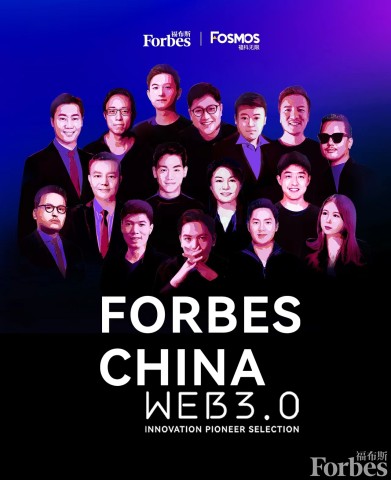
1.Introduction
Nothing is so important until it actually happened.
2022 is the year when “Black Swan” and “Gray Rhino” compete with each other in the digital economy:
“Metaverse” is gradually moving from concept to reality, but Oculus shipments have entered a growth bottleneck period; more and more content creators are creating digital art, but the trading volume of non – homogeneous digital tokens (NFT) has fallen off a cliff; in the “decentralized finance” (DeFi) scenario, mutual trust – based agreements between platforms can reduce barriers and begin to focus more on the pursuit of product services and value innovation, but that won’t stop billions of dollars in stablecoins being redeemed.
As one of the exploration directions of the next generation Internet, although Web 3.0 is highly controversial, the boundaries are still blurred. But it is undeniable that it is trying to improve the relationship between data creators and platforms, starting from blockchain, consensus protocols, and smart contracts. And let users master their own digital identities and digital assets, and then provide the necessary support for the integration and development of the digital economy and the real economy. The new Internet era of the digital economy, represented by Web 3.0, based on trust mechanisms and connecting the virtual world and the real world, is emerging, which makes traditional investment institutions see opportunities.
Today, Web 3.0 has begun to outline what the next generation of the Internet will look like, and this market will become apparent in 2023. The era dominated by Wall Street will end, Asian forces are expected to rise again, and Web 3.0 will return to value innovation led by technology. It will not only be a simple innovation of the Internet application layer, but may also change people’s life, business and transaction methods, and give birth to the next generation of Chinese enterprises that will change the world.
So far, only some pioneers have devoted themselves to Web 3.0, and their commonality is that they are all believers in the technological revolution, and they firmly believe that technical technology will bring about inflammatory processes. Therefore, Forbes China and FOSMOS launched the “2022 Forbes China Web 3.0 Innovation Pioneer Selection”. We aim to find cases of value creation by innovative companies in the field of Web 3.0, and to show how the current wave of Web 3.0 is shaping a new order with higher autonomy.
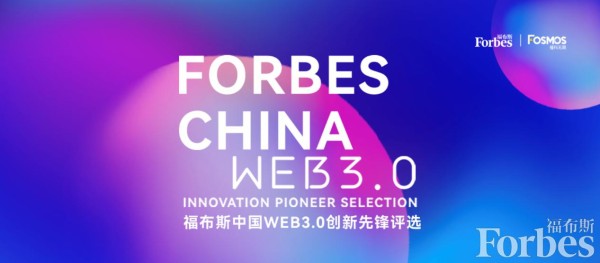
Standing in the torrent of on – chain applications, we believe that these entrepreneurs who are optimistic, diligent, courageous, and daring to have a natural spiritual coupling with Web 3.0, which is full of freedom and adventure; we will also observe from here, what kind of expectations will those people who are constantly pioneering in Web 3.0 bring to the industry.
2.Selection Interpretation
Traditional industries have different definitions of Web 3.0, and the concepts are also dazzling and constantly changing with technological progress. In simple terms, if Web 1.0 was the “read – only” era and Web 2.0 was the “readable and writable” era, then Web 3.0 has become an all – encompassing term for a newer, better Internet vision. Its emergence is to make the Internet more decentralized and secure by designing new technical protocols and building new infrastructure, and allowing users to master their own digital identities and digital assets. Therefore, Web 3.0 is not just a simple innovation of the Internet application layer, but to some extent, it is also an overall evolution and systematic upgrade of the Internet architecture.

Statista shows that in 2021, the amount of investment in Web 3.0 – related fields will reach $30.49 billion, and the number of VC investments and M&A activities will reach 1,349. Since 2022, the enthusiasm for investment in Web 3.0 has continued to rise, with US$14.6 billion invested in this field in Q1. In February 2022, as one of the world’s largest venture capital institutions, Sequoia Capital announced the launch of a fund focused on investing in Web 3.0 – related technology startups, with a fund size of between US$500 million and US$600 million. At the same time, Bain Capital, a well – known private equity investment company in the United States, also established a US$580 million cryptocurrency – specific fund. Take Coinbase Venture, where Emily Choi, the winner of this selection, works as an example. The bull market effect of the encryption market in 2021 has promoted the rapid expansion of Coinbase Ventures’ investment landscape. Its total investment in the past year was close to 150, and there was a new investment every 2.5 days on average. Since 2022, Coinbase Ventures has completed about 150 acquisitions again, and completed more than 70 investments in the first quarter alone.

But behind the vibrant capital, there are also joys and worries. By the middle of 2022, some notable projects once considered Web 3.0 had collapsed one after another. First, the cryptocurrency Luna crashed, and its price fell from close to $90 to less than $0.00015 in a few days; the former “king of P2E chain games” Axie Infinity, its game token SLP also fell below $0.005 overnight, down 99% from the highest point; even FTX, a cryptocurrency exchange with a market value as high as 32 billion US dollars, has recently collapsed… From these cases, we can be seen that the development of the market requires not only capital support, but also the guidance of the government.

At present, China is exploring a Web 3.0 development route that suits its own national conditions, and strives to strike a balance between trends and risks. Although it continues to focus on the supervision of the blockchain industry, it also attaches great importance to the positive role of Web 3.0 in industrial development, and has gradually formed an integrated development path in which the technology industry serves the real industry.
Starting in 2020, China will not only include the blockchain in the outline of the “14th Five – Year Plan” to coordinate the layout, but also actively introduce relevant policies based on the primary national conditions. This emphasizes the combination of various fields and blockchain technology to accelerate the development of blockchain technology and industrial innovation. Government departments and administrative units at all levels continue to increase policy support for blockchain, and promote blockchain technology to empower the real economy in an all – around way.
In July 2022, the General Office of the Shanghai Municipal People’s Government issued the “Shanghai Digital Economy Development 14th Five-Year Plan”, proposing to break through several vital technologies including blockchain; among the key tasks, the plan emphasizes the great value of blockchain in the development of new digital industries, especially digital finance; on October 31, the Financial Secretary of Hong Kong officially released the “Policy Declaration on the Development of Virtual Assets in Hong Kong,” which clarified the Hong Kong government’s policy stance, regulatory guidelines, and pilot plans for the establishment of the virtual asset industry and ecosystem. As a candidate for this selection and the CEO of the Hong Kong Virtual Asset Exchange Limited, Wai Leung Anthony also contributed to further improving the Hong Kong encryption industry norms, trying to make virtual asset investment safer and more convenient.
There is a saying in the industry: “The elite are flocking to Web 3.0”. From the 30 candidates selected in this selection, we can be seen that most of them graduated from world – renowned colleges, and have profound academic backgrounds or rich investment experience. “Internationalization” is their standard “label”, and the business scope of their affiliated companies covers Hong Kong, the United States, South Korea, Singapore and other places. In addition, the selected candidates also embody the commonality of “strong alliance”, and most of the projects are backed by top VCs such as Sequoia, Cathay, and Sourcecode. It is worth mentioning that female Founders are also gradually emerging in the Web 3.0 field—in terms of gender ratio, female candidates account for about 20%.
In addition, China is one of the countries with the most significant number of Internet technical talents worldwide. At present, in Singapore’s Web 3.0 talent structure, developers are in a fault gap, while China not only has abundant application – oriented technical talents, but also has a large number of underlying infrastructure developers. Some people believe that if China can effectively leverage the resources and potential of the Internet, China may be able to “grab the first pot of gold in the world’s Web 3.0.”
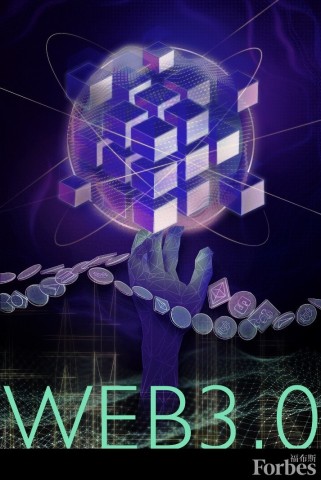
Divided from the architectural level, Web 3.0 has initially formed an architecture including the facility, the basic, the extension, and the application layer. At the same time, based on ensuring security, with the interaction of digital identity marking and digital object capitalization, a new system that supports the integrated development of the real and digital economy is gradually taking shape.
First, the infrastructure layer adapts to the logic rules of the protocol stack, reshaping the form of computing, storage, and communication, and promoting the evolution of the network architecture towards security, flexibility, and scalability. Take the MAP Protocol launched by James Cheng as an example. It is a provable decentralized full – chain infrastructure. It is built with LightClient and zero -knowledge – proof technology. It is a full – chain infrastructure with unprivileged roles in the cross – chain process and can cover all heterogeneous and EVM chains.
Secondly, in terms of expanding the application layer, Web 3.0 projects often use digital wallets as the entrance to connect different fields including finance, social networking, media, and games, and continue to innovate application models.
At the payment level, as the world’s leading compliant cryptocurrency payment company, Alchemy Pay is the developer of the global “Legal Currency – Cryptocurrency” hybrid payment solution, dedicated to solving the stitching problem between cryptocurrency and fiat currency. From the perspective of specific applications, the projects of the selected candidates include: WECO LAND, a metaverse infrastructure product that provides WorkFi for the GameFi pan – entertainment community; Hyperorcale, a new generation of zero – knowledge oracle network, which makes blockchain automation, decentralized machine learning, decentralized quantitative finance, DiFi 3.0 and other applications possible through mathematical security guarantees instead of voting; Registry3, which can promote a fair and open domain name allocation framework for Web 3.0, has been created, which can accelerate the large – scale application of Web 3.0 domain names through a complete internal toolkit.
Finally, from a security standpoint, Web 3.0 offers an opportunity to escape the cybersecurity mistakes of the past, and infosec professionals who realize the technology’s potential have invested in it. For example, MetaTrust Labs, launched by candidate Yang Liu, has focused on Web 3.0 security solutions for a long time. It uses automated security toolchains and intelligent code audit services to bring security and compliance into the development lifecycle.
Currently, Web 3.0 is still in the exploratory stage. Against the backdrop of immature technology and the global regulatory environment, this field has many uncertainties and risks. We will continue to pay attention to the industrial opportunities brought about by Web 3.0 technological innovation and the layout and development of related Internet companies.
3.Selection Method
This selection adopts two methods of open registration and institutional recommendation to recruit candidates, and from the perspective of project market value, we comprehensively inspected application scenario innovation, candidate’s education background, candidate’s entrepreneurial or investment experience, candidate’s educational background, investment institution/invested company and other third – party institutions’ recognition, product or project (investment project)’s contribution to Web 3.0 – related fields, the candidates. Thirty “Web 3.0 Innovation Pioneers” were finally selected.
The complete selection results are as follows, in no particular order:
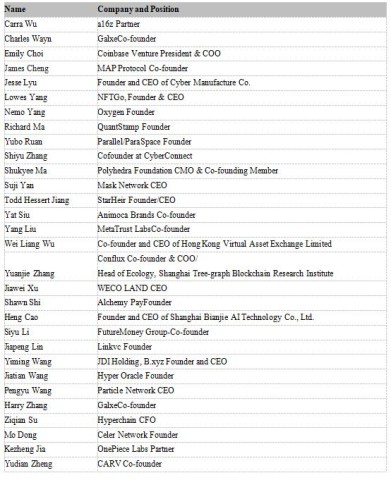
The following are some of the selected “Web3.0 Innovation Pioneers” and their profiles:
Shawn Shi
Alchemy Pay
Alchemy Pay is the developer of the world’s first “Legal Currency – Cryptocurrency” hybrid payment solution, serving customers in more than 70 countries and regions, and is compatible with mainstream international payment methods such as Visa/Mastercard/PayPal and localized payment methods in various countries.
Charles Wayn & Harry Zhang
Galxe
Galxe is a Web 3.0 credential data network and one of the important projects of the DID track, with a market value of 600 million US dollars. It is built on an open and collaborative infrastructure to help Web 3.0 developers build better products and communities through digital credential data and NFT.
Weiliang Wu
Hong Kong Virtual Asset Exchange Limited
Hong Kong Virtual Asset Exchange Limited actively promotes industry compliance and the development of virtual asset licenses, making investing in virtual assets safe and convenient. Its services include a trading platform and digital asset custody services, allowing users to participate in different types of Web 3.0 projects in a trusted environment.
Todd Hessert Jiang
StarHeir
StarHeir is a virtual asset researcher and operator focusing on fashion trends. It has successively incubated and launched Meta Street Market️®️, Otamakee, RaRavila, MET@NEGA, VON11 and other on – chain digital fashion brand matrices. It has issued a total of 70,000+ virtual goods in its history, and has established and operated multiple brand holder communities at the same time. Investors include Netease, Cathay Capital, and Hong Kong New World Development.
Jiawei Xu
WECO LAND
WECO LAND is the metaverse project invested by the core founders of Facebook. It is the world’s leading Web 3.0 Metaverse infrastructure, providing new social capabilities for the pan – entertainment community. It uses blockchain technology to confirm the asset rights of the original content of social networking, so that the intellectual property rights and information rights originally created by users can be better protected.
Yiming Wang
JDI/B.xyz Founder
B.xyz is a one – stop financial service platform located in Hong Kong, while JDI is a Web 3.0 underlying infrastructure service provider, providing hardware for Web 3.0 projects such as Helium, DIMO, and Hivemapper, and is a leader in the DeWi subdivision track.
Jiatian Wang
Hyper Oracle
Hyper Oracle has received $3 million in investment from Sequoia, dao5, Foresight Venture, and FutureMoney. It aims to use the new generation of blockchain technology to solve various problems of the old blockchain middleware network, so as to improve the degree of security and decentralization, and lay the foundation for various defi 3.0 applications. Its zkMiddleware is a new category in the Web 3.0 zk track.
Nemo Yang
Oxygen
Oxygen is committed to promoting an intelligent promotion and growth ecosystem based on WEB3 core technology and becoming the future – oriented Google Ads. Oxygen currently focuses on building talent understanding models and marketing networks through machine learning, collecting more than 600,000 WEB3 talent information, and hundreds of millions of data points for promotional activities. They also ensure bilateral cooperation’s reliability and transparency by automating the core promotion process, enabling project parties and brands to achieve efficient, low – cost, and healthy growth in the WEB3 field. It has been reported by Coindesk, 36Kr, and many other well – known domestic and foreign media.
James Cheng
MAP Protocol
MAP Protocol is the full chain layer of Web 3.0, with provable cross – chain security based on Light – client and ZK technology. It can also link all EVM and non – EVM chains, thus providing safe and smooth cross – chain communication for all chains. Through a full set of SDKs, MAP Protocol empowers dApp developers to implement full – chain deployment to obtain user resource advantages in an all – round way.
Siyu Li
FutureMoney Group
FutureMoney Group is a blockchain/encryption technology/Web 3.0 investment institution incorporated in Singapore in 2018. In the past five years since its establishment, it has invested in more than 100 blockchain/encryption technology/Web 3.0 projects, and is also the limited partner (LP) of dozens of blockchain funds. The institution supports innovation in the blockchain/encryption technology/Web 3.0 industry through compliant US dollar funds, its own funds, and a large number of content outputs.
Pengyu Wang
Particle Network
Particle Network is a Web 3.0 middleware platform. Its core product is MPC login and wallet middleware for developers, which enables end users to log in to Web 3.0 products through various types of Web 2.0 login methods such as telephone, email, Facebook, and Google accounts, and automatically helps users create a non – custodial chain wallet.
Heng Cao
Bianjie AI
Bianjie AI focuses on blockchain technology and application innovation. Its core products include AVATA multi – chain cross – chain distributed application service platform, BSN open alliance chain Wenchang BSN, and the basic chain IRITA product series that supports the next generation of distributed business systems. Bianjie AI cooperates with blockchain service network (BSN), Asia Digital Bank, Hainan International Cultural Artwork Trading Center, Beijing Cultural and Communication Union and other partners, to jointly promote the application of innovative technologies in the fields of metaverse digital collections, cross – chain services, digital finance, and cross – border trade to serve the real economy.
Yang Liu
MetaTrust Labs
MetaTrust Labs focuses on Web 3.0 security solutions, and provides security empowerment for developers and project teams through comprehensive and three – dimensional deep security scanning and dynamic protection.
Suji Yan
Mask Network
Mask Network focuses on the bridge from Web 2.0 social to Web 3.0. The initial product form is to allow users to post encrypted tweets on traditional social networking sites such as Twitter and Facebook to protect their information from being obtained by the platform. Later, it evolved into users using the existing social network to realize decentralized communication, payment, tipping, file storage and sharing functions.
Mo Dong
Celer Network
Celer is a blockchain interoperability protocol that enables cross – chain access to tokens, DeFi, GameFi, NFTs, governance, and more. Developers can use the Celer Interchain Messaging SDK to build interchain native dApps for efficient liquidity utilization, coherent application logic, and shared state.
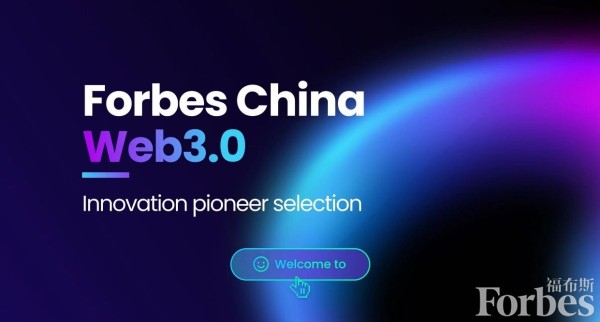
Media Contact
Company Name: Fosmos consulting management co.,ltd.
Contact Person: Matt.sun
Email: Send Email
City: Shanghai
Country: China
Website: www.forbeschina.com





